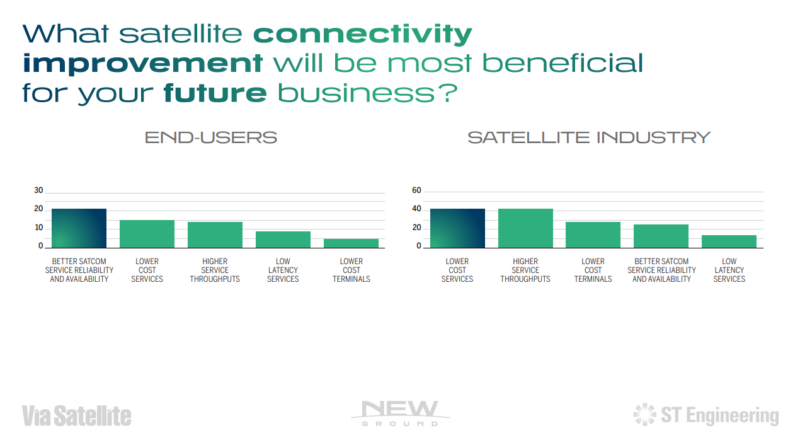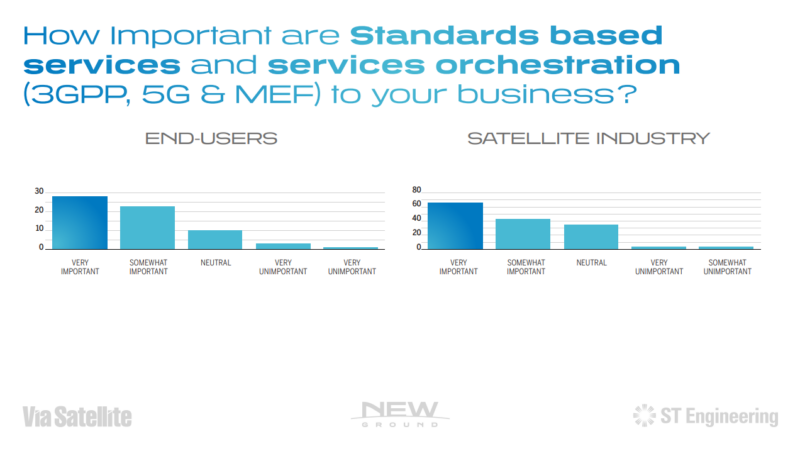The Satellite Industry Gears Up for Open Satcom and 5G Standardized Ecosystems
The satellite industry sees large potential for open satcom and 5G standardized ecosystems, according to a recent industry survey by ST Engineering iDirect in partnership with Via Satellite.
The survey, which garnered about 700 respondents from the satellite industry and related areas including satellite end users, governments, and telcos, demonstrated that open satcom and 5G standardized ecosystems will provide end users with flexibility to integrate satcom, and enable true heterogeneous networks with roaming between satellite and terrestrial. Respondents also expect these standards to expand the market faster.

Let’s take a deeper dive and look at some of the key questions and responses.
Which satellite connectivity improvement will be most beneficial for your future business?
For end users, cost was not the key concern. The main concern was better services over satellite. This is not surprising given the huge increase in bandwidth use that has occurred in the cruise and aero industries, for example, and the demand for ubiquitous bandwidth that can cater for all applications, including video.
Technology has evolved greatly over the last few years, but its impact takes time to be felt. The respondents also did not consider latency to be too much of a concern. For some, it is not as critical as others, and satcom is already optimized to overcome the effects of GEO latency.

This is an interesting response, with many new satellite entrants into the market focused on throughput and cost. However, end users are not willing to compromise on service quality and SLAs.
From the satellite industry perspective, cost and service capability were the important factors. For industry players, a combination of cost and profitability coupled with continued improvement on bandwidth efficiency to provide scalable, reliable and cost-effective services, was top of the priority list.
How important is cloud technology and virtualization to your business?
Just under half of all respondents agreed that the adoption of the cloud and virtualization is going to be important for their business. Here again, end user respondents were less concerned with reduction of costs and more about the expansion of connectivity services with added services and turnkey solutions. They expect cloud technology to expand connectivity offerings with value added services and turnkey solutions. Others say it will attract new customers that satcom does not reach today and reduce overall costs.
For satellite companies, this offers room for innovation and the need for value added services allows the expansion and optimization of remote operations, business processes and workflows, including the cloud, that can be deployed in locations connected by satellite.
How important are standards-based services and services orchestration (3GPP, 5G & MEF) to your business?
Just under a third of respondents agreed that the adoption of standards is important to their businesses. Both end-users and the industry see 5G/3GPP as a key driver for seamless integration and delivery of satcom and terrestrial services. Such standardization will also allow the seamless delivery of advanced services over a mix of heterogeneous networks where end-users will consume services from different networks.

In what timeframe will you adopt 5G/3GPP standardized and orchestrated satcom services?
From the end user standpoint, around a third of respondents didn’t know when they would adopt standardized and orchestrated satcom services, and this is not surprising. The ‘How’ something is delivered is not of great concern to the end user. As long as they are getting the services and quality they need, they are happy.
Similarly, just under a third of the industry were also not sure. However, we must remember that it is completely normal for new technology to permeate and to become adopted. Convergence of standards is also taking time of the terrestrial side. There is still a lot to learn about standards and what benefits they will bring. There are some areas of the industry, such as operators, that will see those benefits immediately and will start work on adoption more quickly than others.
What are the challenges?
This convergence brings some concerns with it as well. The top concern is that full standardization will create more cybersecurity risks for satcom services and this is in line with industry concerns on cybersecurity. Over a third of respondents said cyber hardening their networks and services is very important or somewhat important. Fewer worry that investing in 5G and cloud technologies is beyond their organization’s capabilities, or that their businesses will be challenged or displaced by new entrants.
Key Takeaways
The survey has turned out some valuable insights.
The first is that end users see the value in satcom services and don’t want to compromise their experience and service capabilities for lower costs.
High throughput services with SLAs and value-added services are very important for both the end users and the satellite industry. There is widespread recognition of the importance of the cloud and 5G/5GPP standardization as key enablers in our ability to achieve this,
The responses also demonstrate that low latency is not that critical for most end-users and use cases.
However, it is also very important that the satellite community has ready access to information on the transformation that it is underway and that the work that has been started through the New Ground initiative is continued into the future.